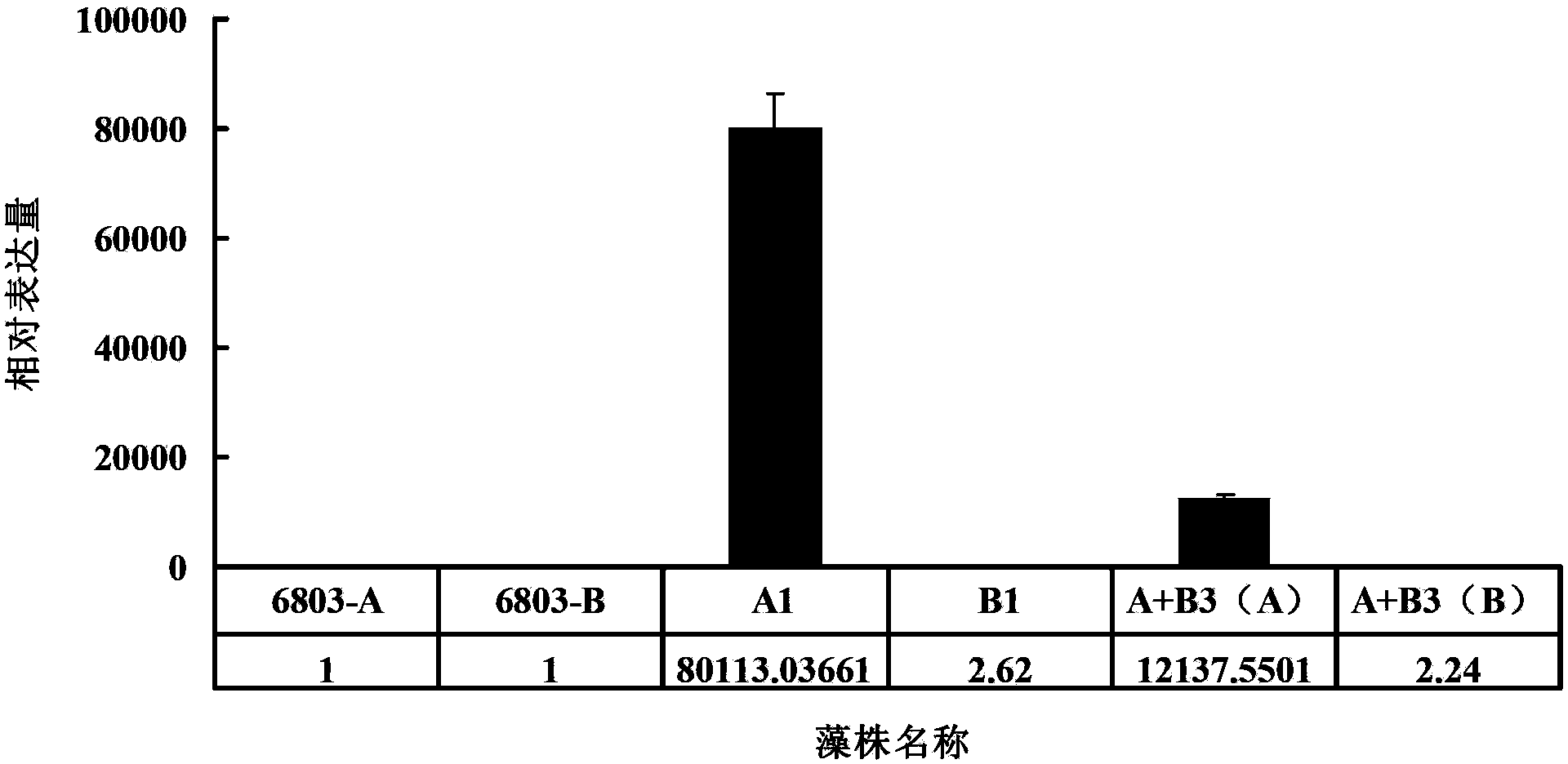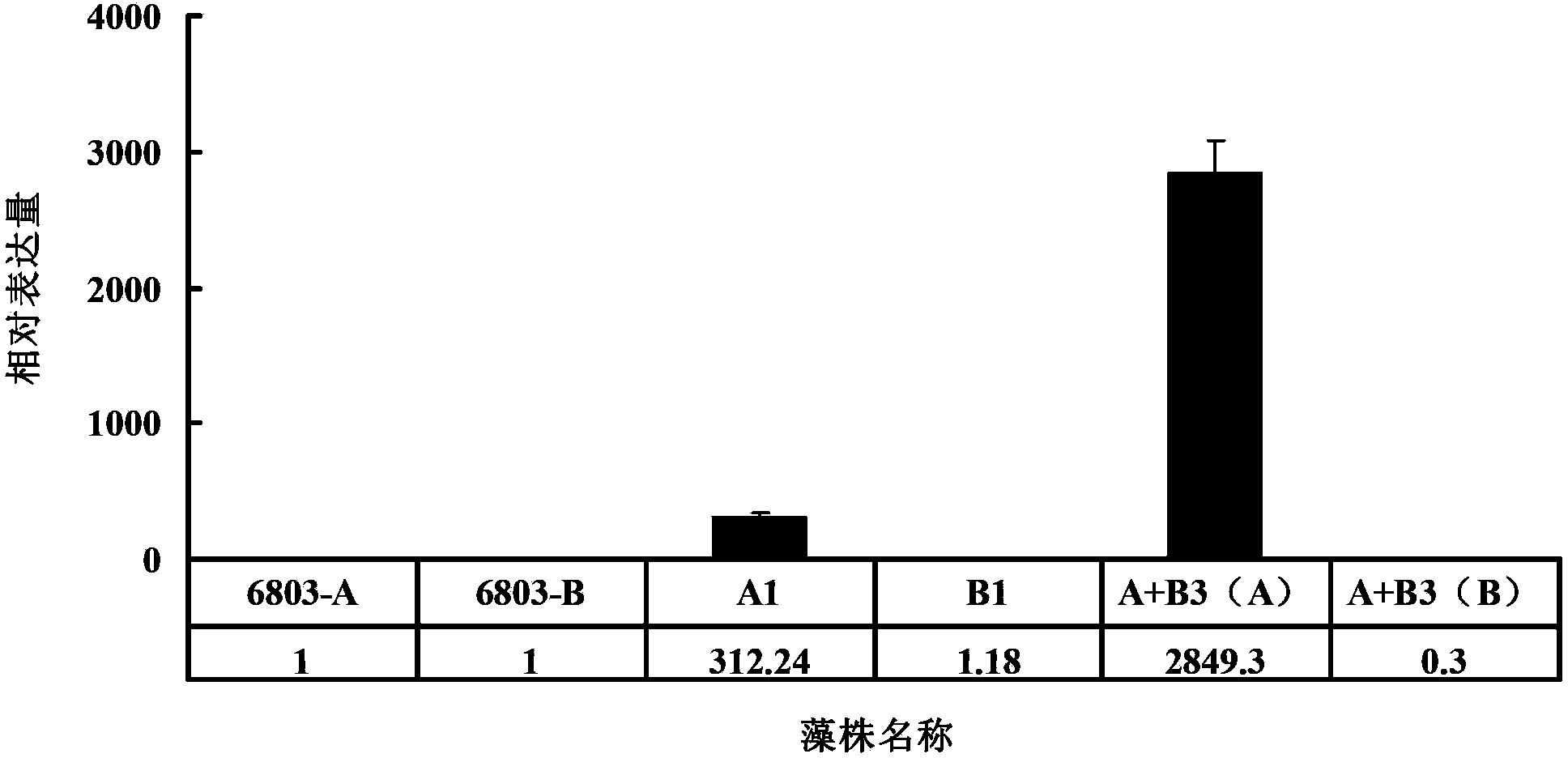Method for improving content of fatty acid in synechocystis PCC6803
A technology of PCC6803 and Synechocystis, which is applied in the field of plant genetic engineering, can solve problems such as the lack of thioesterase gene function research, and achieve the effects of strong low temperature tolerance, enhanced biomass, and increased total fatty acid content
- Summary
- Abstract
- Description
- Claims
- Application Information
AI Technical Summary
Problems solved by technology
Method used
Image
Examples
Embodiment 1
[0065] The cDNA fragments of peanut thioesterase gene AhFatA, peanut thioesterase gene AhFatB1, fusion gene AhFatA+AhFatB1 and homologous recombination fragment psbA2ORF cDNA fragments used to construct the expression vector of Synechocystis sp. PCC6803 were isolated and cloned.
[0066] Cloning of Synechocystis sp. PCC6803psbA2ORF gene fragment:
[0067] Primers were designed according to the psbA2ORF cDNA sequence in Synchocystis sp. PCC6803 (accession number: BA000022, AP012205, sequence shown in SEQ ID NO.7, Synchocystis sp. PCC6803) registered in GenBank:
[0068] psbA2-F: 5'-CTTGCGGCCGCCATATGCCGCGGATGACAACGACTTCTCCAAC-3',
[0069] psbA2-R: 5'AGTGAGCTCTTAACCGTTGACAGCAGG-3',
[0070] The amplification program was as follows: pre-denaturation at 94°C for 5 min; denaturation at 94°C for 30 s, renaturation at 58°C for 30 s, extension at 72°C for 1 min, after 35 cycles; extension at 72°C for 10 min, and storage at 4°C.
[0071] After the PCR reaction, the gel was recovered b...
Embodiment 2
[0100] Construction and Transformation of the Expression Vector of Synechocystis sp. PCC6803
[0101] In order to better study the function of the peanut sulfatase gene, the inventors made the peanut sulfatase gene AhFatA and AhFatB1 expressed in Synechocystis sp. PCC6803 by overexpression technology. Function of the peanut sulfatase gene.
[0102] Preparation of plasmid pBluscript SK plus T1T2:
[0103] Amplify the plasmid pKK233-2 of the E. coli T1T2 terminator, introduce a PstI restriction site at its 5' end, and introduce a BamHI restriction site at its 3' end. The primers used are:
[0104] T1T2-F: 5'-ATACTGCAGCCAAGCTTGGCTGTTTTGGC-3';
[0105] T1T2-R: 5'-TTAGGATCCCCCATTATTGAAGCATTTAT-3';
[0106] The amplification program was as follows: pre-denaturation at 94°C for 5 min, denaturation at 94°C for 30 s, renaturation at 60°C for 30 s, extension at 72°C for 1 min, after 35 cycles, 10 min at 72°C, and storage at 4°C. The obtained fragment was double digested with PstI an...
Embodiment 3
[0114] Detection of the expression levels of peanut sulfatase gene AhFatA, peanut sulfatase gene AhFatB1 and AhFatA+AhFatB1 in transgenic Synechocystis positive plants
[0115] Total RNA was extracted from transgenic Synechocystis sp. PCC6803 containing expression vectors pSDFatA, pSDFatB1, pSDFatA+FatB1 and wild type Synechocystis sp. PCC6803 for Real time quantitative PCR analysis.
[0116] The specific operation steps are as follows: Take 50ml of cyanobacteria with OD=1.8, centrifuge at 5000rpm at 4°C for 10min to collect the algae cells, grind them in liquid nitrogen until they are fine powder, add them to a 1.5ml centrifuge tube, quickly add 1ml TRIZOL (Invitrogen), mix by inversion Evenly, let stand at room temperature for 5 minutes, centrifuge at 11900rpm at 4°C for 10min, take the supernatant into a new 1.5ml centrifuge tube, add 200μl chloroform, shake vigorously by hand for 15s, let stand for 3-5min, centrifuge at 11900rpm at 4°C 10-15min. Take the supernatant into ...
PUM
 Login to View More
Login to View More Abstract
Description
Claims
Application Information
 Login to View More
Login to View More - R&D
- Intellectual Property
- Life Sciences
- Materials
- Tech Scout
- Unparalleled Data Quality
- Higher Quality Content
- 60% Fewer Hallucinations
Browse by: Latest US Patents, China's latest patents, Technical Efficacy Thesaurus, Application Domain, Technology Topic, Popular Technical Reports.
© 2025 PatSnap. All rights reserved.Legal|Privacy policy|Modern Slavery Act Transparency Statement|Sitemap|About US| Contact US: help@patsnap.com



